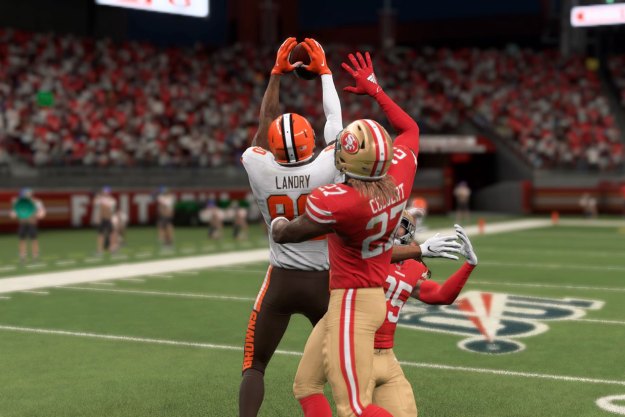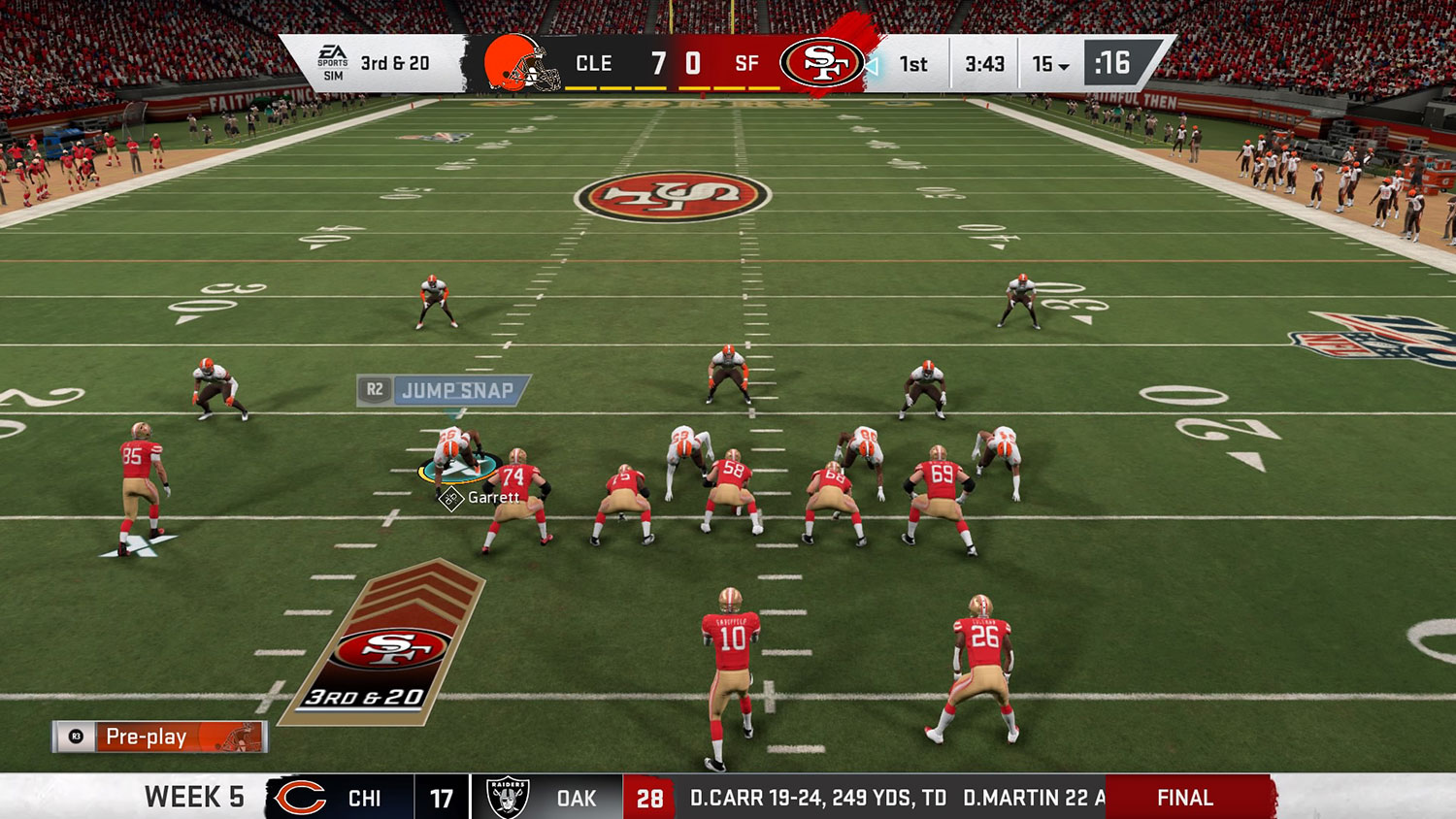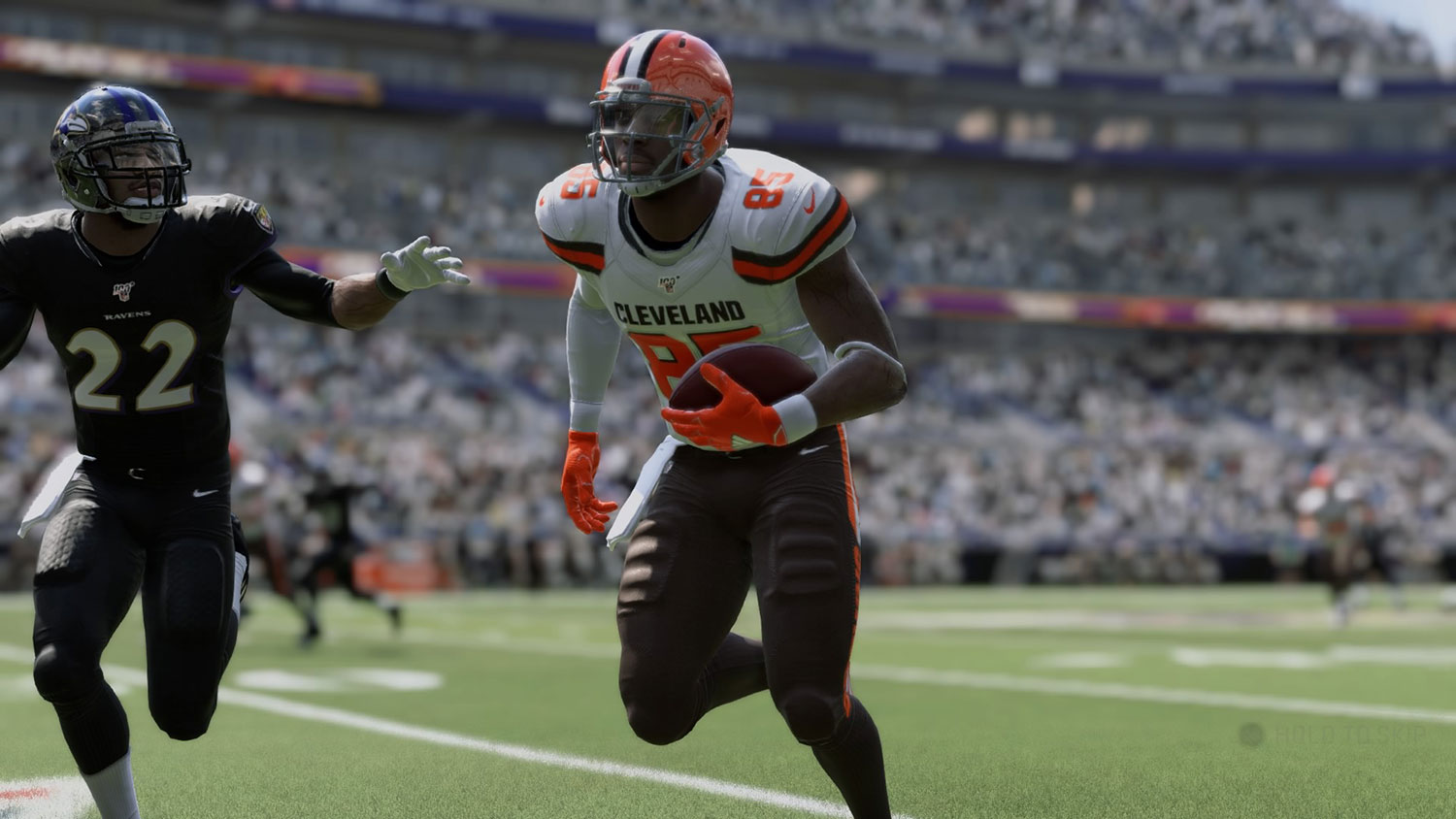
“Madden NFL 20’s Ultimate Team and Franchise modes are superb, but the career mode misses the mark.”
- Missions make Ultimate Team a joy
- Overhauled player ratings system
- Improved passing game
- Superstar X-Factor is a nice touch
- The running game isn’t balanced
- Face of the Franchise severely underwhelms
In some ways, Madden NFL 20 is the best entry in the long-running series. The overhauled ratings system makes a clear difference, and Ultimate Team continues to become more accessible thanks to the new streamlined “missions” format. In other ways, Madden NFL 20 takes a step back. The run game, which felt as close to balanced as ever last year, is now bordering on cheat code level efficiency (at least against the CPU). And the new Face of the Franchise career mode is a resounding dud.
Developer EA Tiburon continues to shake up the formula to varying levels of success. Franchise and Ultimate Team continue to be exceedingly deep and rewarding experiences, but EA still hasn’t cracked the code when it comes to creating a compelling career mode.
Nothing but open field
John Madden once said that “the road to Easy Street goes through the sewer.” Well, in Madden NFL 20, Easy Street is apparently anywhere on the field for a star running back. And unlike a trip through the sewer, my running backs would have pristine jerseys when crossing the goal line for a long touchdown.
The run game, which has traditionally been a bit too strenuous, has burst wide open in Madden NFL 20, swinging the pendulum completely the other way. Even when playing on All-Madden difficulty, my Browns running back tandem of Kareem Hunt and Nick Chubb averaged north of 10 yards per carry. I’ve lost track of how many 50-plus yard touchdowns I’ve scored that started with outside pitches.

The last time I ran for so many long touchdowns in Madden, I was playing as Madden NFL 2004 cover athlete Michael Vick, who was basically the embodiment of a cheat code. The running game has been an uphill battle in Madden for years, so it’s surprising to see this major turn.
This isn’t a good thing. At first, I was overjoyed to find so many open lanes. I thought I was playing better. But that’s not the case. I can run four tosses to either side of the field in a row and gain significant positive yardage on at least three of them. It doesn’t add up. The same goes for inside runs and scrambling with the QB. Playing as Baker Mayfield, who isn’t particularly speedy, I can scramble out of the pocket and regularly run for 15 to 20 yards — also on All-Madden difficulty.
I mention the difficulty not because I’m an amazing Madden player. In fact, I normally play on Pro or All-Pro difficulty. But after finding far too much success, I bypassed All-Pro and went straight for All-Madden. I noticed no changes in my yards-per-carry average between difficulty levels. I imagine the run game will become more balanced post-launch, but as of now, if you spend a lot of time playing against the CPU, you’re going to run all over them.
If you spend a lot of time playing against the CPU, you’re going to run all over them.
The passing game, on the other hand, has much better balance. Unlike the run game, I always had to think about where and when to throw the ball, taking into account the type of pass I needed to throw to get the ball to where only my receiver could haul it in. In this regard, player animations for stars seem more in step with their real-life counterparts. Baker Mayfield’s quick and unique release is on display and Odell Beckham Jr. makes one-handed catches in a manner that is uncanny.
The addition of RPOs — run-pass options — to the playbook is a nice bonus that competitive Madden players will certainly enjoy. On the other side of the ball, I found defense to be quite similar to Madden NFL 19. Tackling with the hit stick is just as satisfying as it’s been for several years now. Critically, I didn’t find it much harder than last year to stop the run, when playing against the CPU or live opponents.
The main difference I’ve seen on defense is in the secondary. So far, I’ve picked off more passes than usual. Not as many passes deflect off of a defender’s hands for no reason. If you put yourself in the right spot, forcing turnovers seems a tad easier than before.
Ultimate Team and Franchise
Madden’s marquee modes, Ultimate Team and Franchise, each benefit from refined progression mechanics. Since these are the two modes players spend by far the most time with on average, the improvements are greatly appreciated.
Starting with Ultimate Team, the mode has received a welcome makeover. Yes, this is still the card-collecting bonanza that you probably either love or hate, but it’s far more accessible without sacrificing its immense depth.
To help you navigate the complex world of Ultimate Team, EA has added Missions, a blueprint for completing challenges and earning rewards. You can follow the wisdom imparted by the Missions menu as much or as little as you wish. What’s cool about Missions is that you can access Ultimate Challenges (solo or co-op challenges) or multiplayer matches and keep tabs on your milestones right there in the Missions menu. From clear guidelines on what to do to raise your MUT level to percentage trackers keeping tabs on your work towards new items and cards, Missions makes Ultimate Team a pleasure to navigate.

Ultimate Team also has more appeal for solo players this time around. Despite the name change from Solo Challenges to Ultimate Challenges, there’s more to do for those who prefer to play against the CPU. Each Ultimate Challenge has a star system that rolls into rewards. Since rewards are tied to milestones rather than specific challenges, it benefits to replay challenges for higher star ratings. The more you play, the more challenges you unlock.
Naturally, if you don’t care for the card-collecting loop itself, the inviting structure probably won’t be enough to win you over. After all, Ultimate Team’s player ratings and upgrades system is a serious RPG. But I do think that the nudge in the right direction with Missions could wind up influencing casual Ultimate Team fans to stick around much longer.
Ultimate Team can still be a money pit if you get really into it. Card packs and currency can be purchased, but you also earn coins and packs. You don’t need to spend additional money to enjoy Ultimate Team.
Madden’s marquee modes, Ultimate Team and Franchise, each benefit from refined progression mechanics.
Franchise mode’s improvements are far more subtle but still meaningful nonetheless, especially for those who play through a handful or more full seasons. EA has taken a more strict approach to the player ratings system. The difference between a player rated 90 versus one at the same position rated 85 is substantial. To be quite honest, you could easily look at your team and say, “I’m going to make my worst receiver the league leader in reception yards.” And then you could for sure make that happen. Though still possible, ratings actually feel like they really mean something in Madden NFL 20. When Baker Mayfield went out for a quarter with a minor injury, I noticed a marked difference playing as the backup Drew Stanton. When Rashard Higgins ran the same route as OBJ, I had to adjust to their differences in speed and capability.
Why is this important to franchise mode? Well, franchise is all about development, the gradual experience point gains that turn into bumps in stat categories. Now you have to be wiser when doling out stat points. The same goes for scouting college players and the draft. Previously, I disregarded potential because overall ratings didn’t impact my thinking. But when I reached the end of my first season, I was mindful of my positional needs and keenly aware of which prospects had the best development trajectory.
Though seemingly a minor, background change, the adjustments to the ratings system make franchise mode a more engrossing, consequential journey.
Separating elite from great
Adding onto the new player ratings system is the Superstar X-Factor feature. 50 of the most elite players in the NFL — OBJ, Jalen Ramsey, Todd Gurley II, etc. — have unique abilities that unlock when you meet a certain condition in-game. For example, cover athlete Patrick Mahomes II can throw the ball an extra 15 yards after completing a 30-plus yard pass. Once he’s sacked, the perk expires. X-Factor players also have multiple innate abilities that simply make them better already in certain facets of the game.
Other high caliber players are dubbed Superstars. While they cannot get “in the zone” to unlock a perk, they have innate abilities that make them better.
Importantly, Superstar X-Factor players don’t feel like cheat codes, but the new feature further complements the overhauled ratings system in a way that benefits the overall experience. You’ll miss J.J. Watt’s superior edge rushing when he’s on the sideline.
Friday Night Lights off
For the third straight year, EA attempted to create a compelling story mode. Madden NFL 18’s cinematic Longshot mode was superb. Madden NFL 19’s direct sequel to Longshot was a total bummer. Longshot is gone in Madden NFL 20, replaced by Face of the Franchise, a mode that is ostensibly similar to Road to the Show (MLB The Show) and MyCareer (NBA 2K). Except unlike its competitors, Face of the Franchise is bad.
The premise: You’re a 5-star QB recruit with your pick of college destinations. Like Longshot, Face of the Franchise has an NCAA presence. You get to create your player and then choose between ten high profile programs, including Clemson, Oregon, Oklahoma, and USC.

After choosing your school, you arrive on campus to learn that the number one prospect in the country has changed his mind and decided to commit to your school of choice. Fast forward four years and your team is in the College Football Playoff. The other 5-star QB and four-year starter was injured, presumably in bowl practice, and now you will get to start your first college game. Not only is it your first start, you’ve never even seen the field. For anyone who has watched big time programs play, you already know how ludicrously implausible it is that the backup QB never saw a single snap in four years.
Superstar X-Factor complements the overhauled ratings system in a way that benefits the overall experience.
But I digress. You either get to play one or two games (if you win the first) in college before the NFL Combine. Weirdly, the college game seem to have a mix of NFL and NCAA rules. For instance, the extra point attempt after a touchdown follows college rules in terms of distance, but pass interference penalties are spot penalties, not 15-yard penalties like they actually are in college football. These may sound like trivial complaints, but don’t expect Face of the Franchise’s beginning to feel like the reincarnation of NCAA Football.
The cinematic presentation fades away after the draft and a few more baffling story beats to reveal a rather conventional franchise mode. The difference is that you only control the QB. Once you pass, the CPU takes over. Once you hand the ball off, the CPU takes over. You never play defense. Besides a simplistic text message system where you talk with your coach between games, Face of the Franchise is pretty bare bones. Road to the Show and MyCareer have multitudes; Face of the Franchise is one-dimensional.
Microtransactions
EA Sports games have revolved around Ultimate Team for years. As a mode focused on card-collecting, the quickest way to improve your team is to throw money at it. Prices vary but generally you’re paying about one dollar per card. Most card packs can also be purchased with in-game currency, but you’ll have to grind challenges to earn enough coins for some of the more lavish packs that contain the best players.
I’ve never felt tempted to spend money in Ultimate Team. If you dig the solo loop, you earn enough coins to continuously upgrade your team –- admittedly, at a slower rate. However, if you want to be competitive online out of the gate, purchasing card packs can certainly help.
Our Take
Madden NFL 20 is a stellar football sim, especially for those who enjoy Franchise or Ultimate Team. The reworked player ratings system adds authenticity to the on-the-field gameplay, and Ultimate Team is easier to follow than ever before. It’s not without its faults, though. The running game feels like a cheat code, and Face of the Franchise is a boring, poorly written career mode.
Is there a better alternative?
No, EA Sports is the only studio with an NFL license, so you won’t find a serious football sim outside of Madden nowadays. But if you want something far more casual, Mutant Football League is the closest to NFL Blitz you can find.
How long will it last?
I spent around 20 hours with Franchise, Ultimate Team, and Face of the Franchise. I’ve only scratched the surface. Madden is a football-season-long event.
Should you buy it?
Yes. This year’s Madden is not without flaw, but its improvements to Ultimate Team are appreciated.
Editors' Recommendations
- Madden 23 Face of the Franchise: Tips, tricks, and best positions
- The best teams in Madden 23
- How to pre-order Madden NFL 23: retailers, editions, and bonuses
- Madden NFL 23’s ‘no-brainer’ cover star is John Madden
- Madden 22 predicts the Bengals will win Super Bowl LVI



